The fall of 2011 definitely classifies as one of my "coming back" moments. Here is a summary of the latest tournaments I played:
- "Memorial Ongaro", 5 rounds swiss, 20' per player plus 30" increments - Venice July 2011, 50 players (okay not yet summer but it belongs to the series): 3/5 (three wins, two losses). Here I played fairly well most of my games, but duly lost to Roberto Pastres (a master) and Giorgio Redo (a strong candidate master).
- Semilampo Mira, 9 rounds swiss, 15' per player (no increments) - Mira 8 October 2011, 42 players: 5,5/9 (five wins, one draw, three losses) - fourth prize. Here I did great: I lost three games against a grandmaster and two international masters, as expected, but won all the rest against less strong players, except a draw after few moves at the last round (it guaranteed me the fourth place behind the three titled players).
- "Rapid Autunno 2011", 5 rounds swiss, 40' per player plus 30" increments plus 20' after move 40 - Venice, chess club "Esteban Canal", September-October 2011, 16 players: 3/5 (three wins, two losses). I lost awfully the first game to a second-category player due to a unrecoverable blunder, won three more, and then lost to fide master Antonio Rosino after refusing a draw by repetition (with a win I would win the tournament).
- "Autunno Scacchistico Veneziano 2011 - Open A", 5 rounds swiss, 90' per player plus 30" increments plus 20' after move 40 - Venice, October 30-November 1, 56 players: 3/5 (two wins, two draws, one loss). Here I suffered a loss due to having to leave the tournament hall for a meeting I could not delay, but generally played well. Below (after the last tournament in the list) I attach a position from the last game of this tournament, where I had white against a first-category player.
- "Scacco al re di cioccolato", 6 rounds swiss, 15' per player (no increments) - Stra (VE) 5/11/2011, 70 players: 5/6 (four wins, two draws), fifth prize. I played impeccably this strong tournament, which saw the participation of two international masters, a fide master, and over a dozen italian masters. All but the first player I met had at least 2000 elo points, and yet I managed to obtain better positions in all but one game, ending up unbeaten.
----
Here is the position from the "Autunno Scacchistico Veneziano" I mentioned above:
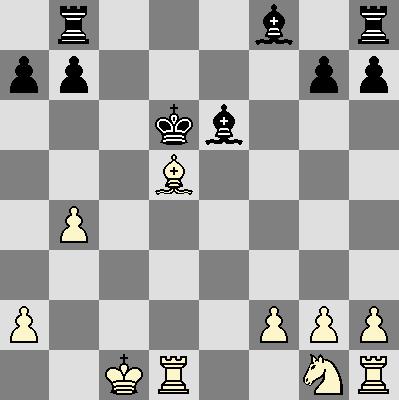
Here I am white, and through an inaccuracy of my opponent I have managed to obtain a winning position. How would you play as white now ? There are two moves that spring to mind. The computer rather likes 1.Bb3+ better than 1.Bc4+, while I chose the latter. If one analyzes further than just a few moves, however, one realizes that the position arising from 1.Bc4+! is easier to win. Let us see:
A) 1.Bb3+ Ke7 2.Re1 Rc8+ 3.Kb2 Rc6 4.Nf3 Kf6 5.b5 (5.Nd4 Bxb3 6.Nxc6 Bd5 7.Nxa7 Bxb4 8.Rd1 Bxg2 9.Rhg1 Bh3 is not so conclusive) Rd6 6.Bxe6 Rxe6 7.Rxe6+ Kxe6 8.Ng5+ Kf5, and white is better but there is still a lot to play;
B) 1.Bc4+! Ke7 2.Re1 Rc8 3.Rxe6+ Kd7 4.Re4 b5 5.Kb2 bxc4 6.Kc3 Bd6 7.Nf3 Rhe8 8.Rhe1 and the position plays itself. I won in nine more moves, in fact.
--------------------
And here is my game with master Alaster Pechy from the last tournament in the list above, with minimal commentary:
T. Dorigo - A. Pechy, Mira 5/11/2011
1.e4 c5 2.c3 Nf6 3.e5 Nd5 4.d4 cxd4 5.Qxd4 e6 6.Bc4 Nc6 7.Qe4 Nc7 8.Nf3 d5 9.exd6 Qxd6 (diagram):
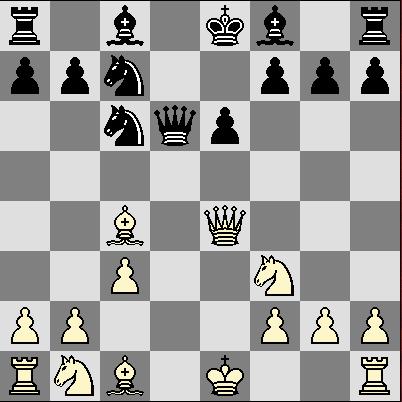
Black has chosen a minor variation in this opening (7...Nc7), but the move which is the source of his troubles is rather 9....Qxd6, which delays development and subjects black to a strong attack. Better was 9....Bxd6.
10.Bf4 Qd8 11.0-0 Bd7 12.Rd1 Rc8 13.Ne5! Nxe5 14.Bxe5
Black is prevented from developing his forces and castling. The position is already much better for white.
14.... Qg5 15.f4 Bc5+ (diagram)
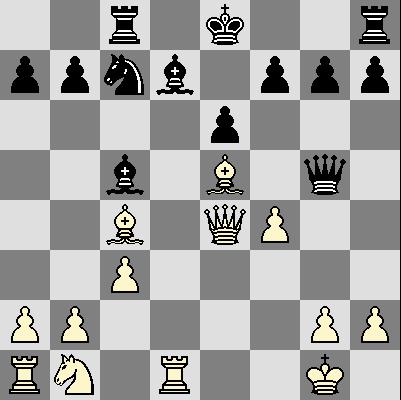
Better was 15.... Qe7 16.Qxb7 Qc5+ 17.Rd4 Qc6, although white retains the advantage there too.
16.Kh1!
Of course not 16.Bd4 Qh5 [but not 16....Bxd4+ 17.Qxd4! with double attack on d7 and g7] 17.Be2 Qd5! where most of white's advantage would have vanished.
16.... Qg4 17.Be2 Qg6 18.Qxb7 Bb6 19.Na3!
Here I had seen of course that 19.Bb5 wins forcefully the Bd7. However, when you play a 15' game and you have a winning position, it is crucial to prevent your opponent from developing any counterplay. We had less than 5' each by now, and the variation 19.Bb5 0-0 20.Bxd7 Rb8 21.Qc6 did not appeal to me as much as the variation I chose in the game, which continues to exert pressure and poses difficult problems to black.
19.... f6 20.Nc4! (diagram)
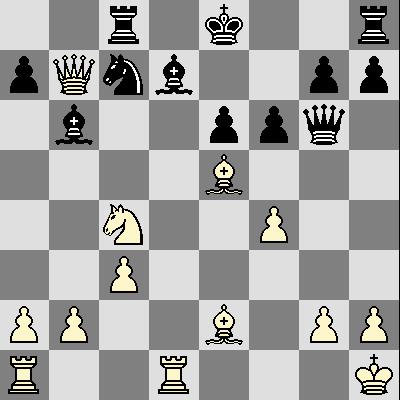
20.... Nd5
Of course, if 20....fxe5 21.Nxe5 wins. Here, however, white would have a mortal blow which I overlooked: 21.f5!!. I leave the interested readers to discover by themselves the variations. Note that the move I chose (21.Nd6+) also wins easily, so I don't think I can reproach myself too much for not looking into all the variations coming from 21.f5.
21.Nd6+ Ke7 22.Nxc8+ Rxc8 23.Bb5 Qe8 24.c4
Slightly better was 24.Txd5, but I was again being pragmatic here, with two minutes on my clock.
24.... fxe5 25.cxd5 exd5 26.Rxd5 Rc7 27.Rxe5+ (diagram)
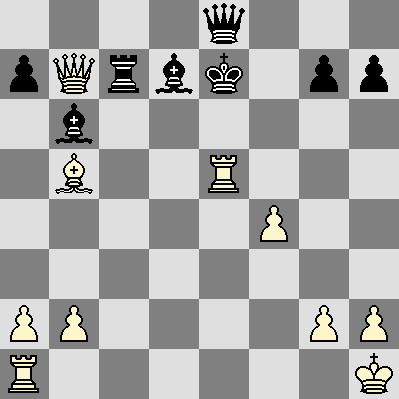
and black continued with 27....Kf6 but lost quickly the endgame resulting after 28.Qxc7! - Here too, note that 28.Qxd5 is more accurate, but not advisable with 40" to finish the game.





Comments